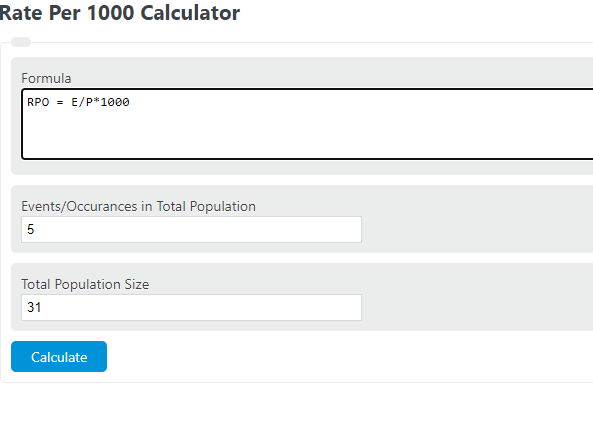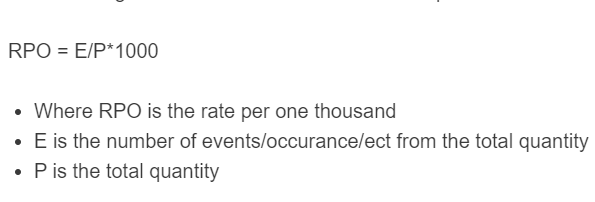Enter any total quantity and the number of events or cases into the calculator to determine the rate per 1000.
Rate Per 1000 Formula
The following formula is used to calculate a rate per 1000.
RPO = E/P*1000
- Where RPO is the rate per one thousand
- E is the number of events/occurrences/etc from the total quantity
- P is the total quantity
To calculate the rate per 1000, divide the total number of occurrences by the total quantity, then multiply by 1000.
Rate Per 1000 Definition
A rate per 1000 is typically used to describe the total number of events or cases in a population per 1000 people. This can be applied to any data set of numbers, like the rate of defects per 1000 manufactured goods and so on.
Rate Per 1000 Example
How to calculate rate per 1000?
The first step in calculating the rate per 1000 is to determine the total population or data set size that you are using for the problem.
In this case, the total population size is calculated to be 12000.
Next, the number of occurrences in that population must be measured. These occurrences could be failures of a product, rates of defects, or any other measure of occurrence.
For this example, we are looking at a product that is being made in a factory and there were 500 units that came out with failures out of the total population.
Finally, calculate the rate per 1000 using the formula above:
RPO = E/P*1000
RPO = 500/12000*1000
RPO = 41.667 failures per 1000.
FAQ
What is the significance of calculating a rate per 1000?
Calculating a rate per 1000 allows for the standardization of data across different sizes of populations or data sets, making it easier to compare rates of occurrences, such as crime rates or disease incidence, across different areas or groups.
Can the rate per 1000 formula be applied to any type of data?
Yes, the rate per 1000 formula can be applied to any type of quantitative data where measuring the occurrence of an event relative to the size of the population or data set is meaningful. This includes fields such as public health, manufacturing, and social sciences.
How does the rate per 1000 differ from a percentage?
The rate per 1000 measures the number of occurrences per 1000 units, providing a specific count, whereas a percentage represents a fraction of 100, showing a proportion. The rate per 1000 is useful for expressing smaller occurrences in large populations or data sets.
Why multiply by 1000 in the rate per 1000 formula?
Multiplying by 1000 in the formula scales the rate of occurrences to a base of 1000 units, making it a more tangible figure for comparison and analysis, especially in large populations or data sets where occurrences per unit might be very small.

